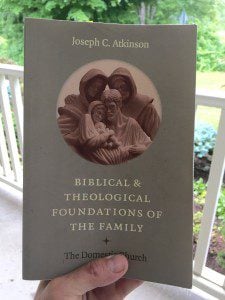There is a deep and unalterable connection between this world and the next. And that connection is reflected in the marriage of a man and a woman.
The fact that many people have lost touch physically with creation (this world), and notionally with the new creation (the next), just goes to show how the reduction of Christianity to a “personal relationship with Jesus” is destroying Christianity. If you’re one of those people that does this, knock it off.
There is a “conservative” evangelical way to do it, just as there is a “liberal” way to. But both of these ways, as irreconcilable as they may seem on the surface, have more in common with each other than they do with traditional Christianity. And the reason that they do is they share in common the falsehood that the world we live in is a meaningless place with no future.
How did this happen? Well, it has a lot to do with liberalism’s pyrrhic victory in its war to destroy religion.
 It is pyrrhic because liberalism denies the intrinsically social creatureliness of human beings. It assumes that people are social atoms, then posits a null-space where these atoms can choose whether or not to enter social life. It the process it denies the physically bifurcated nature of human beings as male and female–denying the obvious truth that human beings are mammals surrounded by other species that are similarly bifurcated. And it does so because this offends an unnatural and impossible notion that true freedom is arbitrary freedom.
It is pyrrhic because liberalism denies the intrinsically social creatureliness of human beings. It assumes that people are social atoms, then posits a null-space where these atoms can choose whether or not to enter social life. It the process it denies the physically bifurcated nature of human beings as male and female–denying the obvious truth that human beings are mammals surrounded by other species that are similarly bifurcated. And it does so because this offends an unnatural and impossible notion that true freedom is arbitrary freedom.
But anyone looking at the modern world knows that this doctrine of arbitrary freedom cloaks forms of corporate life that have replaced the family. I’m speaking of corporations and welfare states, naturally. But even though these anthills as currently conceived are hostile to family life, parasitically they rely upon healthy families for their existence.
In my last post I noted that for the children of Abraham the family–and yes, I mean family in the traditional sense as instituted through the union of a man and a woman–is the carrier of God’s covenant with Abraham. But Joseph C. Atkinson in his book, Biblical and Theological Foundations of the Family demonstrates that the family is significant for another reason: it is the image of the covenant. It in the words of Marshall McLuhan, the medium is the message.
It is important to note here that the connection between creations is intrinsic, not extrinsic. It is not as though God happens upon traditional marriage as a handy illustration of a back-up plan for a new creation after the first creation is spoiled in the Garden. Rather, the new creation is always plan A and marriage–again, a man and a woman becoming one flesh, just to make sure everyone is clear on this–is the sign that points to it. It was always the sign that points to it.
Here’s something from Biblical and Theological Foundations of the Family that underscore this:
The relationship of marriage and family to the divine covenant was not an artificial construction. It was precisely because of their created natures and their prior ordination towards communion that marriage and family were able to receive the mission to image forth the reality of the covenant within the created order. (p.134)
But there is even more to it than this.
Households are not fully self-contained systems–they are not atoms either. They contain gift-giving and subsistence economies, but they need a larger order to dwell in. Corporations and states are not intrinsically wrong, they just tend to make idols of themselves–like other goods–when God is forgotten. When that happens they become predatory, like Molech, and begin to breakdown households.
But households are not self-referential either. They allude to the very highest values, or at least they should. Households can make idols of themselves, too. But when they do they prey upon themselves. It is only when our households direct us to the new creation that they glorify God and become a joy to live in. And they do that by bodying-forth the temple as it was prefigured in the Garden–where the common labor of a man and a woman became a commonwealth. And it was there that the Lord himself communed with his regents, the Lord Adam and the Lady Eve, in the cool of the day.
Usually this is where the subject of the place and work of the church comes up when I discuss these themes with people. I’ll talk about that a little in my next post.
—
Here’s something else for you to enjoy. Wipf and Stock, the publisher of my book, Man of the House, has given me permission to share a little sample of the book with you. The hope, of course, is you will like it enough to purchase a copy. Enjoy!.
Click here to download the book excerpt as a PDF: Man of the House_Excerpt













